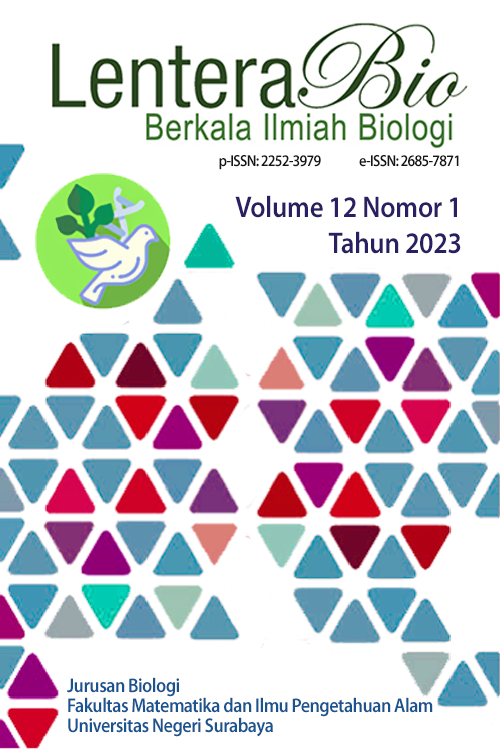Isolation and Characterization of Lead (Pb) Degrading Bacteria in Lamong Bay, Surabaya
DOI:
https://doi.org/10.26740/lenterabio.v12n1.p101-106Keywords:
Bacteria, Indigenous, Lead Metal Pb, Lamong Bay SurabayaAbstract
Industrial and human activities can increase lead (Pb) metal waste in Lamong Bay, Surabaya, which is located in Asemrowo District, Surabaya. Increasing activities may lead higher pollution rate in that area. Therefore, an alternative method is needed to deal with Pb heavy metal pollution in the waters. One alternative is biodegradation using indigenous bacteria. This research aimed to isolate and characterize indigenous Pb-degrading bacteria from Lamong Bay, Surabaya. The steps in this research were isolation using media containing Pb (10 ppm) followed by characterization of potential bacteria based on macroscopic and microscopic observations. Macroscopic observations included the morphology of the colony, while microscopic observations included Gram type, cell shape, and cell arrangement. The results obtained two bacterial isolates that grew dominantly on the media containing 10 ppm Pb. The isolates were coded as TLS0.3 and TLS0.7. The TLS0.3 isolate showed gram-positive characteristics and coccus-shaped cells, while the TLS0.7 isolate was a gram-negative bacteria in the form of a bacillus. Based on the results of this research, it can be concluded that two bacterial isolates have the potential to degrade Pb. The two bacterial isolates need to be further identified so that their potential as Pb-degrading agents can be optimized.
Downloads
Published
How to Cite
Issue
Section
License
Copyright (c) 2023 LenteraBio : Berkala Ilmiah Biologi

This work is licensed under a Creative Commons Attribution-NonCommercial 4.0 International License.
Hak Cipta (c) LenteraBio: Berkala Ilmiah Biologi
Karya ini dilisensikan di bawah Lisensi Internasional Creative Commons Attribution-NonCommercial 4.0.
Pemberitahuan Hak Cipta.
Hak cipta dari artikel yang diterima untuk diterbitkan akan diberikan kepada jurnal sebagai penerbit jurnal. Hak cipta yang dimaksud meliputi hak untuk menerbitkan artikel dalam berbagai bentuk (termasuk cetak ulang). Jurnal mempertahankan hak penerbitan atas artikel yang diterbitkan.
 Abstract views: 1149
,
Abstract views: 1149
, PDF Downloads: 2447
PDF Downloads: 2447











